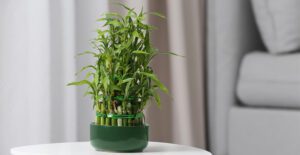Feng Shui Lucky Bamboo Tips

One of the most popular feng shui cures is the use of lucky bamboo—container arrangements of several stalks of either of two houseplant species, Dracaena sanderiana or Dracaena braunii. The stalks grow in a container filled with stones or pebbles covered with water; no soil is used. Lucky bamboo closely resembles true bamboo, but it is an entirely different plant species than bamboo, which is actually grass rather than an herbaceous perennial.
Lucky bamboo is a very popular houseplant in thousands of homes, and you can now find arrangements for sale almost anywhere—often in supermarkets and gift shops, as well as garden stores and home improvement gardening centers. But lucky bamboo is especially significant for those who practice feng shui, for whom the plant has a particular meaning. Feng shui enthusiasts may want to create their own arrangements to maximize the effectiveness of an energy cure.
The Meaning of Lucky Bamboo in Feng Shui
For feng shui enthusiasts, lucky bamboo is an amazing plant that brings very peaceful and wise energy into your home. It teaches the ultimate wisdom: how to be flexible and hollow (open) on the inside so that the spirit can freely flow and heal your being. The benefits of lucky bamboo inside your home also extend to true bamboo growing in your garden or to accessories and accents made from stalks of bamboo. For example, if you are lucky enough to have bamboo growing in your garden, you know how soothing, almost transcendental, the sound of wind rustling through the stalks and leaves can be. The same is true for bamboo feng shui wind chimes, and the energy of bamboo flooring can also profoundly affect a home.
A Lucky Bamboo Plant Arrangement
For the proper feng shui impact, a lucky bamboo arrangement should combine and represent all five feng shui elements, considered the foundation of a harmonious universe: water, wood, fire, earth, and metal.
- Wood: The lucky bamboo plant (as do all plants) expresses the feng shui wood element.
- Earth: The rocks filling the lucky bamboo container or vase create the plant’s foundation for the plant, thereby representing the earth element.
- Water: The water the bamboo needs for its vibrant growth obviously represents the water element.
- Fire: A lucky bamboo plant used as a feng shui cure should have a red ribbon tied to it—the color red is the fire element’s expression.
- Metal: The glass pots that contain most lucky bamboo plants represent the metal element. If your lucky bamboo is planted in a ceramic pot, it should have either a metal coin (Chinese coins for good luck) or a metal figurine, such as the laughing buddha.
When used as a feng shui cure, the number of stalks in the lucky bamboo planting has a specific meaning that should be taken into consideration. You can have as many stalks as you wish, but there are some traditional symbolic numbers you may want to follow when using a lucky bamboo arrangement as a feng shui cure:
- 2 stalks for Love & Marriage
- 3 stalks for Happiness
- 5 stalks for Health
- 8 stalks for Wealth and Abundance
- 9 stalks for Good Fortune
Placing Lucky Bamboo
For the best feng shui, your lucky bamboo should be placed in your wealth & money or health & family Bagua areas. If you are working with the classical feng shui Bagua, these are the southeast and east feng shui areas of your home Bagua. In the Western/BTB Bagua case, place the plant in the mid-left and upper left areas of your home.
Caring for Lucky Bamboo
We have seen countless “lucky” bamboo plants struggling to survive and have a poor, neglected look; the only luck in them is the “lucky to be alive” factor! Even though lucky bamboo is easy to care for and a very tolerant plant, it still needs your love and attention. As it likes to look good, just like you do. Do not be afraid to touch your lucky bamboo and take good care of it.
Ultimately, the lucky bamboo considers lucky because of its peaceful vitality and strong growth, and cultivating these virtues requires that you take good care of it, as you should with any plant.
